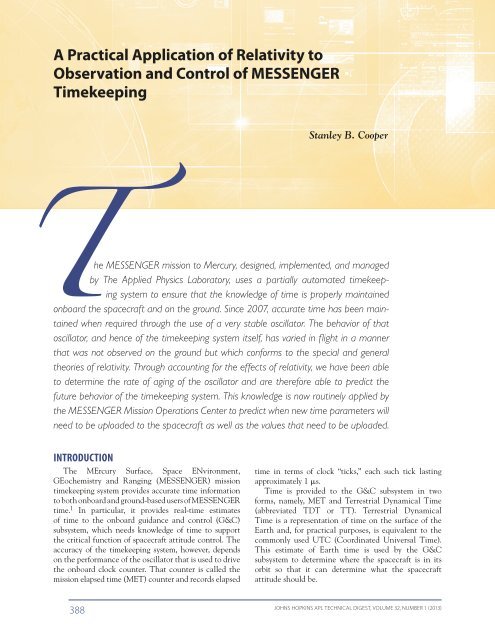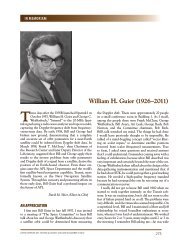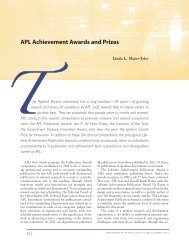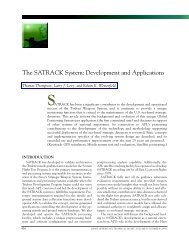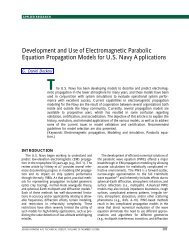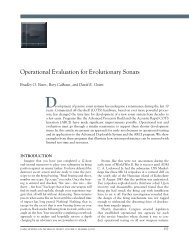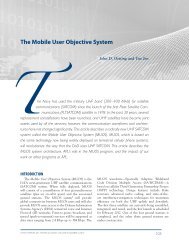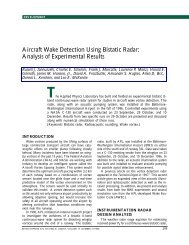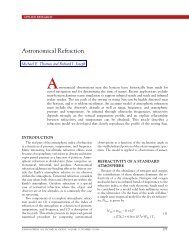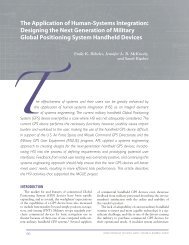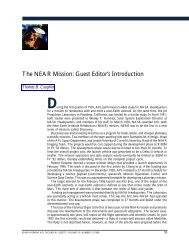A Practical Application of Relativity to Observation and Control of ...
A Practical Application of Relativity to Observation and Control of ...
A Practical Application of Relativity to Observation and Control of ...
You also want an ePaper? Increase the reach of your titles
YUMPU automatically turns print PDFs into web optimized ePapers that Google loves.
A <strong>Practical</strong> <strong>Application</strong> <strong>of</strong> <strong>Relativity</strong> <strong>to</strong><br />
<strong>Observation</strong> <strong>and</strong> <strong>Control</strong> <strong>of</strong> MESSENGER<br />
Timekeeping<br />
INTRODUCTION<br />
The MErcury Surface, Space ENvironment,<br />
GEochemistry <strong>and</strong> Ranging (MESSENGER) mission<br />
timekeeping system provides accurate time information<br />
<strong>to</strong> both onboard <strong>and</strong> ground-based users <strong>of</strong> MESSENGER<br />
time. 1 In particular, it provides real-time estimates<br />
<strong>of</strong> time <strong>to</strong> the onboard guidance <strong>and</strong> control (G&C)<br />
subsystem, which needs knowledge <strong>of</strong> time <strong>to</strong> support<br />
the critical function <strong>of</strong> spacecraft attitude control. The<br />
accuracy <strong>of</strong> the timekeeping system, however, depends<br />
on the performance <strong>of</strong> the oscilla<strong>to</strong>r that is used <strong>to</strong> drive<br />
the onboard clock counter. That counter is called the<br />
mission elapsed time (MET) counter <strong>and</strong> records elapsed<br />
388<br />
Stanley B. Cooper<br />
he MESSENGER mission <strong>to</strong> Mercury, designed, implemented, <strong>and</strong> managed<br />
by The Applied Physics Labora<strong>to</strong>ry, uses a partially au<strong>to</strong>mated timekeeping<br />
system <strong>to</strong> ensure that the knowledge <strong>of</strong> time is properly maintained<br />
onboard the spacecraft <strong>and</strong> on the ground. Since 2007, accurate time has been maintained<br />
when required through the use <strong>of</strong> a very stable oscilla<strong>to</strong>r. The behavior <strong>of</strong> that<br />
oscilla<strong>to</strong>r, <strong>and</strong> hence <strong>of</strong> the timekeeping system itself, has varied in flight in a manner<br />
that was not observed on the ground but which conforms <strong>to</strong> the special <strong>and</strong> general<br />
theories <strong>of</strong> relativity. Through accounting for the effects <strong>of</strong> relativity, we have been able<br />
<strong>to</strong> determine the rate <strong>of</strong> aging <strong>of</strong> the oscilla<strong>to</strong>r <strong>and</strong> are therefore able <strong>to</strong> predict the<br />
future behavior <strong>of</strong> the timekeeping system. This knowledge is now routinely applied by<br />
the MESSENGER Mission Operations Center <strong>to</strong> predict when new time parameters will<br />
need <strong>to</strong> be uploaded <strong>to</strong> the spacecraft as well as the values that need <strong>to</strong> be uploaded.<br />
time in terms <strong>of</strong> clock “ticks,” each such tick lasting<br />
approximately 1 ms.<br />
Time is provided <strong>to</strong> the G&C subsystem in two<br />
forms, namely, MET <strong>and</strong> Terrestrial Dynamical Time<br />
(abbreviated TDT or TT). Terrestrial Dynamical<br />
Time is a representation <strong>of</strong> time on the surface <strong>of</strong> the<br />
Earth <strong>and</strong>, for practical purposes, is equivalent <strong>to</strong> the<br />
commonly used UTC (Coordinated Universal Time).<br />
This estimate <strong>of</strong> Earth time is used by the G&C<br />
subsystem <strong>to</strong> determine where the spacecraft is in its<br />
orbit so that it can determine what the spacecraft<br />
attitude should be.<br />
JOHNS HOPKINS APL TECHNICAL DIGEST, VOLUME 32, NUMBER 1 (2013)
The spacecraft actually contains four oscilla<strong>to</strong>rs that<br />
can be used <strong>to</strong> support onboard timekeeping. The current<br />
configuration <strong>of</strong> the spacecraft avionics allows either<br />
<strong>of</strong> two <strong>of</strong> those oscilla<strong>to</strong>rs <strong>to</strong> be used <strong>to</strong> drive the MET<br />
counter. One is a very stable oven-controlled crystal<br />
oscilla<strong>to</strong>r (OCXO) that is used <strong>to</strong> provide the timekeeping<br />
system accuracy required <strong>to</strong> support science observations.<br />
Owing <strong>to</strong> reliability concerns, however, the other<br />
less-stable “coarse” oscilla<strong>to</strong>r is used <strong>to</strong> drive the MET<br />
counter whenever an engine burn is performed. This has<br />
occurred numerous times—during cruise, during Mercury<br />
orbit insertion (MOI), <strong>and</strong> also at many solar perihelia<br />
<strong>and</strong> aphelia while the spacecraft is in orbit around<br />
Mercury. This occasional deselection <strong>of</strong> the “precision”<br />
oscilla<strong>to</strong>r, the OCXO, has produced numerous gaps in<br />
our record <strong>of</strong> OCXO performance. Even with those<br />
gaps, however, some very interesting <strong>and</strong> useful information<br />
has been gathered about the behavior <strong>of</strong> the OCXO<br />
<strong>and</strong> <strong>of</strong> the timekeeping system itself.<br />
The timekeeping system produces, on the ground,<br />
an estimate <strong>of</strong> the correlation between MET <strong>and</strong> Earth<br />
time in terms <strong>of</strong> the TT system. It saves that estimate<br />
in a text file called the Operations SCLK (Spacecraft<br />
Clock) Kernel. The SCLK Kernel estimate <strong>of</strong> clock<br />
behavior directly maps <strong>to</strong> average oscilla<strong>to</strong>r behavior.<br />
When the OCXO is selected, comparison <strong>of</strong> that average<br />
oscilla<strong>to</strong>r behavior <strong>to</strong> how we would predict the<br />
oscilla<strong>to</strong>r <strong>to</strong> behave according <strong>to</strong> the special <strong>and</strong> general<br />
theories <strong>of</strong> relativity provides us with knowledge <strong>of</strong> how<br />
much the OCXO behavior deviates from those predictions.<br />
Those “residuals” tell us how the physical OCXO<br />
actually behaves, as a local observer on the spacecraft<br />
would see it. Trending those residuals allows us <strong>to</strong> predict<br />
how the OCXO will behave in the future, <strong>and</strong> that<br />
prediction, in turn, is routinely used by the MESSEN-<br />
GER Mission Operations Center at APL <strong>to</strong> control the<br />
onboard real-time estimate<br />
<strong>of</strong> Earth time (TT) used by<br />
the G&C subsystem. 2<br />
The MESSENGER timekeeping<br />
system has not<br />
only provided us with the<br />
practical result <strong>of</strong> accurate<br />
onboard time for the G&C<br />
subsystem but has also provided<br />
a rare opportunity<br />
<strong>to</strong> have a glimpse, however<br />
small, in<strong>to</strong> the theoretical<br />
universe <strong>of</strong> Albert Einstein.<br />
THE VENUS FLYBY IN 2007<br />
In early 2007, the MES-<br />
SENGER spacecraft began<br />
<strong>to</strong> use the oscilla<strong>to</strong>r designated<br />
OCXO-B <strong>to</strong> control<br />
the spacecraft clock. Shortly<br />
Frequency <strong>of</strong>fset (clock drift rate) (ppb)<br />
35<br />
30<br />
25<br />
20<br />
15<br />
10<br />
5<br />
Actual MET drift rate<br />
Residual clock drift rate<br />
MET drift rate minus velocity effect<br />
afterward, the spacecraft had its second flyby <strong>of</strong> Venus<br />
<strong>to</strong> provide a gravity-assisted course correction on its<br />
long journey <strong>to</strong>ward Mercury. The variation in OCXO<br />
behavior that was evident from the behavior <strong>of</strong> the MET<br />
counter as estimated in the Operations SCLK Kernel<br />
was much greater than we had seen during testing on<br />
the Earth <strong>and</strong> was much greater than could be explained<br />
by environmental fac<strong>to</strong>rs such as the sensitivity <strong>of</strong> the<br />
OCXO output frequency <strong>to</strong> temperature variations. The<br />
explanation lies in the theory <strong>of</strong> relativity, which tells us<br />
that both velocity <strong>and</strong> gravity can measurably affect the<br />
observed behavior <strong>of</strong> a distant clock or oscilla<strong>to</strong>r. Time,<br />
according <strong>to</strong> the theory, is not the same for all observers.<br />
<strong>Observation</strong>s during the 2 months after the OCXO<br />
was selected, including the closest approach <strong>to</strong> Venus<br />
during the second MESSENGER flyby <strong>of</strong> Venus, are<br />
illustrated in Fig. 1. The observed OCXO fractional<br />
frequency <strong>of</strong>fset (bot<strong>to</strong>m curve) varied by 11 parts per<br />
billion (ppb), much more than we had observed during<br />
ground testing. That is equivalent <strong>to</strong> a variation in the<br />
MET counter <strong>of</strong> 11 ns/s or 0.95 ms/day. This OCXO was<br />
cus<strong>to</strong>m designed <strong>to</strong> limit sensitivity <strong>to</strong> environmental<br />
fac<strong>to</strong>rs <strong>and</strong>, for example, was designed <strong>to</strong> allow only<br />
4 ppb OCXO fractional frequency variation or 0.35 ms/<br />
day over the full 40°C operational temperature range.<br />
Also, the oscilla<strong>to</strong>r experienced a temperature variation<br />
<strong>of</strong> only 4°C during the Venus flyby. The frequency<br />
changes that we observed were much greater than environmental<br />
variations could cause.<br />
Let’s focus first on the effect <strong>of</strong> velocity on the oscilla<strong>to</strong>r<br />
frequency performance. Special relativity tells us that<br />
time on the spacecraft (the MET counter) is related <strong>to</strong> the<br />
time perceived by a distant observer by the Lorentz fac<strong>to</strong>r<br />
= 1/ [1 − (v 2 /c 2 )] 0.5 , where c is the speed <strong>of</strong> light <strong>and</strong> v<br />
is the magnitude <strong>of</strong> the velocity <strong>of</strong> the spacecraft in the<br />
coordinate frame <strong>of</strong> the distant observer. Because oscil-<br />
0 960 970 980 990 1000 1010 1020 1030 1040 1050<br />
Days since launch<br />
Figure 1. Residual MESSENGER OCXO-B behavior after March 2007 turn-on.<br />
JOHNS HOPKINS APL TECHNICAL DIGEST, VOLUME 32, NUMBER 1 (2013) 389
S. B. COOPER<br />
la<strong>to</strong>r frequency <strong>and</strong> clock<br />
time are closely related, the<br />
Lorentz fac<strong>to</strong>r also describes<br />
how our observation <strong>of</strong><br />
OCXO frequency is related<br />
<strong>to</strong> the oscilla<strong>to</strong>r frequency<br />
that would be seen by an<br />
observer traveling with<br />
the spacecraft. Subtracting<br />
this effect from our data,<br />
the bot<strong>to</strong>m curve in Fig. 1,<br />
leads <strong>to</strong> the middle curve.<br />
All computations are with<br />
respect <strong>to</strong> the solar barycenter,<br />
that is, the velocity is<br />
the velocity <strong>of</strong> the spacecraft<br />
according <strong>to</strong> an observer at<br />
the solar barycenter.<br />
A particularly interesting<br />
feature <strong>of</strong> these curves<br />
is that the jump in OCXO<br />
fractional frequency <strong>of</strong>fset that appears near the end<br />
<strong>of</strong> the observed data is absent from those data after<br />
removal <strong>of</strong> the relativistic velocity effect. That jump<br />
corresponds <strong>to</strong> the simultaneous reduction in velocity,<br />
shown in Fig. 2, which resulted from the close flyby <strong>of</strong><br />
Venus. (The apparent time shift in the observed jump in<br />
OCXO frequency compared with the time <strong>of</strong> the jump<br />
in velocity is an artifact <strong>of</strong> the way the frequency jump<br />
was computed, but that detail is discussed later.)<br />
The general theory <strong>of</strong> relativity provides the <strong>to</strong>ols for<br />
underst<strong>and</strong>ing how gravity affects the output frequency<br />
<strong>of</strong> the OCXO. The stronger the gravity field experienced<br />
by the oscilla<strong>to</strong>r, the slower that oscilla<strong>to</strong>r runs, at least<br />
as seen by a distant observer in a fixed gravity field. That<br />
behavior is described by<br />
the expression −(GM/c 2 )/R,<br />
where G is the gravitational<br />
constant, M is the mass <strong>of</strong><br />
the body that is the source<br />
<strong>of</strong> the gravity, c is again the<br />
speed <strong>of</strong> light, <strong>and</strong> R is the<br />
distance from that same<br />
body. For Fig. 1, M is the<br />
mass <strong>of</strong> the Sun, <strong>and</strong> R is the<br />
distance <strong>of</strong> the spacecraft<br />
from the Sun. The gravitational<br />
effect <strong>of</strong> Venus was<br />
also examined but found <strong>to</strong><br />
be negligible on the scale<br />
shown in the figure. The<br />
residual OCXO drift rate<br />
shown, the <strong>to</strong>p curve in<br />
Fig. 1, is the result <strong>of</strong> subtracting<br />
both the gravitational<br />
effect <strong>and</strong> the velocity<br />
390<br />
Frequency <strong>of</strong>fset (clock drift rate) (ppb)<br />
35<br />
30<br />
25<br />
20<br />
15<br />
10<br />
5<br />
Actual MET drift rate<br />
MET drift rate minus velocity effect<br />
Spacecraft velocity<br />
0<br />
0<br />
960 970 980 990 1000 1010 1020 1030 1040 1050<br />
Days since launch<br />
Figure 2. MESSENGER OCXO-B behavior after March 2007 turn-on, with relativistic velocity effect<br />
removed.<br />
Fractional frequency <strong>of</strong>fset (clock drift rate) (ppb)<br />
15<br />
10<br />
5<br />
0<br />
–5<br />
–10<br />
–15<br />
–20<br />
effect from the observed data. The variation <strong>of</strong> residual<br />
frequency <strong>of</strong>fset from 31.0 ppb <strong>to</strong> 30.4 ppb over 70 days<br />
is reasonable <strong>and</strong> can be explained by a combination <strong>of</strong><br />
temperature effects <strong>and</strong> oscilla<strong>to</strong>r frequency aging.<br />
This tells us that, after removal <strong>of</strong> the relativistic<br />
effects, the OCXO was running fast by approximately<br />
30–31 ppb, approximately 2.6–2.7 ms/day.<br />
TDTRATE AND THE MERCURY FLYBYS<br />
After the 2007 flyby <strong>of</strong> Venus, the MESSENGER<br />
spacecraft flew past Mercury three times <strong>and</strong> then, in<br />
a fourth encounter, went in<strong>to</strong> orbit around Mercury.<br />
From the Venus flyby, we were able <strong>to</strong> infer from the<br />
Estimated OCXO-B frequency<br />
<strong>of</strong>fset with relativistic effects<br />
Estimated TDTRATE with<br />
relativistic effects<br />
–25<br />
0.99999998500<br />
1220 1240 1260 1280 1300 1320 1340 1360<br />
Days since launch<br />
JOHNS HOPKINS APL TECHNICAL DIGEST, VOLUME 32, NUMBER 1 (2013)<br />
50<br />
45<br />
40<br />
35<br />
30<br />
25<br />
20<br />
15<br />
10<br />
5<br />
1.00000002500<br />
1.00000002000<br />
1.00000001500<br />
1.00000001000<br />
1.00000000500<br />
1.00000000000<br />
0.99999999500<br />
0.99999999000<br />
Figure 3. Estimated MESSENGER OCXO-B fractional frequency <strong>of</strong>fset <strong>and</strong> TDTRATE during M1 due<br />
<strong>to</strong> relativity, assuming +31 ppb <strong>of</strong>fset without relativity.<br />
Spacecraft velocity (km/s)<br />
TDTRATE (s/s)
ehavior <strong>of</strong> the MET counter<br />
how the OCXO behaved. We<br />
also determined that, with<br />
relativistic effects removed,<br />
the OCXO was running fast,<br />
that is, the OCXO output frequency<br />
was higher than the<br />
nominal design frequency.<br />
Prior <strong>to</strong> the first encounter<br />
with Mercury (M1), we<br />
reversed that process <strong>and</strong>,<br />
with the assumption that the<br />
OCXO was still running fast<br />
by the amount determined<br />
from the Venus data, derived<br />
the expected behavior <strong>of</strong><br />
the OCXO <strong>and</strong> <strong>of</strong> the MET<br />
counter. That result is shown<br />
in Fig. 3, calculated using<br />
spacecraft velocity relative <strong>to</strong><br />
the Sun <strong>and</strong> the gravitational effects <strong>of</strong> both the Sun<br />
<strong>and</strong> Mercury. One curve is the OCXO output frequency<br />
<strong>and</strong> equivalent clock drift rate expressed in parts per<br />
billion. Note how the oscilla<strong>to</strong>r <strong>and</strong> clock slowed down<br />
as solar perihelion was approached. The other curve<br />
expresses the clock behavior in terms <strong>of</strong> the parameter<br />
TDTRATE, an important metric <strong>of</strong> interest <strong>to</strong> Mission<br />
Operations Center staff. Note that the observations <strong>of</strong><br />
clock behavior during the 2007 Venus flyby were actually<br />
observations <strong>of</strong> TDTRATE that were converted<br />
<strong>to</strong> the equivalent oscilla<strong>to</strong>r frequency <strong>of</strong>fset behavior<br />
shown in Figs. 1 <strong>and</strong> 2.<br />
TDTRATE is obtained from the Operations SCLK<br />
Kernel. The Jet Propulsion Labora<strong>to</strong>ry’s Navigation <strong>and</strong><br />
Ancillary Information Facility (NAIF) provides <strong>to</strong> APL<br />
<strong>and</strong> <strong>to</strong> other users a suite <strong>of</strong><br />
s<strong>of</strong>tware <strong>and</strong> information<br />
system <strong>to</strong>ols called Spacecraft<br />
Planet Instruments C-matrix<br />
Events (SPICE), designed <strong>to</strong><br />
provide access <strong>to</strong> information<br />
about space missions.<br />
One component <strong>of</strong> SPICE is<br />
a set <strong>of</strong> “kernels” or parameter<br />
files that contain information<br />
relative <strong>to</strong> specific missions<br />
or <strong>to</strong> space missions in general.<br />
For example, ephemerides<br />
kernels might provide<br />
the ephemerides <strong>of</strong> planets<br />
or <strong>of</strong> specific spacecraft. One<br />
type <strong>of</strong> SPICE kernel is the<br />
SCLK kernel, a text file that<br />
provides mappings between<br />
MET <strong>and</strong> Earth time. Each<br />
time record <strong>of</strong> the SPICE<br />
TDTRATE (s/s)<br />
1.00000003000<br />
1.00000002500<br />
1.00000002000<br />
1.00000001500<br />
1.00000001000<br />
1.00000000500<br />
1.00000000000<br />
0.99999999500<br />
0.99999999000<br />
AN APPLICATION OF RELATIVITY TO SPACE MISSION TIMEKEEPING<br />
Estimated TDTRATE with<br />
relativistic effects<br />
Measured interpolated<br />
TDTRATE<br />
0.99999998500<br />
1220 1240 1260 1280 1300 1320 1340 1360<br />
Days since launch<br />
Figure 4. Estimated MESSENGER OCXO-B TDTRATE during M1 due <strong>to</strong> relativity, assuming<br />
+31 ppb OCXO fractional frequency <strong>of</strong>fset without relativity, compared with actual TDTRATE.<br />
TDTRATE (s/s)<br />
1.00000003000<br />
1.00000002500<br />
1.00000002000<br />
1.00000001500<br />
1.00000001000<br />
1.00000000500<br />
1.00000000000<br />
0.99999999500<br />
0.99999999000<br />
0.99999998500<br />
0.99999998000<br />
SCLK kernel contains three fields: (1) a field equivalent<br />
<strong>to</strong> MET, (2) a field representing Earth time, <strong>and</strong> (3)<br />
a clock change rate. At APL, our SCLK kernels have<br />
always expressed Earth time in the TT time system (previously<br />
abbreviated TDT), <strong>and</strong> we have typically called<br />
the clock change rate TDTRATE.<br />
The st<strong>and</strong>ard JPL SPICE SCLK kernel defines the<br />
clock change rate as a rate <strong>to</strong> be used <strong>to</strong> extrapolate the<br />
current MET–TT mapping <strong>to</strong> future times. At APL, we<br />
describe that rate as a “predicted TDTRATE.” Predicted<br />
TDTRATE is used, for example, in predicting the future<br />
time <strong>of</strong> execution <strong>of</strong> a comm<strong>and</strong> <strong>and</strong> is used <strong>to</strong> provide<br />
real-time estimates <strong>of</strong> time <strong>to</strong> the G&C subsystem.<br />
However, the APL-defined Operations SCLK Kernel<br />
takes that a step further <strong>and</strong> recalculates TDTRATE<br />
V2 is second Venus yby<br />
M1 is rst Mercury yby<br />
M2 is second Mercury yby<br />
M3 is third Mercury yby<br />
MOI is Mercury orbit insertion<br />
Estimated TDTRATE with relativistic effects<br />
Measured TDTRATE<br />
0 500 1000 1500 2000 2500 3000<br />
Days since launch<br />
JOHNS HOPKINS APL TECHNICAL DIGEST, VOLUME 32, NUMBER 1 (2013) 391<br />
V2<br />
M1<br />
M2<br />
M3 MOI<br />
Figure 5. Estimated MESSENGER OCXO-B TDTRATE, including the effects <strong>of</strong> relativity, assuming<br />
+28 ppb OCXO fractional frequency <strong>of</strong>fset without relativity, using orbit determination solution<br />
OD153.
S. B. COOPER<br />
for past times <strong>to</strong> provide<br />
a more accurate mapping<br />
between MET <strong>and</strong> TT. That<br />
improved mapping is needed<br />
<strong>to</strong> provide the time accuracy<br />
required for analysis <strong>of</strong><br />
science observations. That<br />
interpolated TDTRATE is<br />
shown in Fig. 3. The interpolated<br />
TDTRATE is based on<br />
both the current time record<br />
in the SCLK kernel <strong>and</strong> on<br />
the next time record, so the<br />
computed TDTRATE <strong>and</strong><br />
derived oscilla<strong>to</strong>r frequency<br />
“lead” the actual performance<br />
<strong>of</strong> the oscilla<strong>to</strong>r. That<br />
is why the change in oscilla<strong>to</strong>r<br />
frequency shown in Fig. 2<br />
appears <strong>to</strong> occur slightly<br />
before the actual change in spacecraft velocity during<br />
the Venus flyby.<br />
A comparison between the interpolated TDTRATE<br />
taken from the Operations SCLK Kernel after the M1<br />
flyby <strong>and</strong> the relativistic prediction <strong>of</strong> TDTRATE given<br />
in Fig. 3 is shown in Fig. 4. The comparison is fairly good<br />
but not perfect <strong>and</strong> suggested that the +31 ppb OCXO<br />
fractional frequency <strong>of</strong>fset <strong>of</strong> the Venus flyby might need<br />
<strong>to</strong> be adjusted.<br />
Analysis <strong>of</strong> TDTRATE following the second flyby <strong>of</strong><br />
Mercury (M2) provided a better fit <strong>of</strong> +28 ppb <strong>to</strong> the<br />
M1 <strong>and</strong> M2 data, after relativistic effects were removed.<br />
However, that same analysis did not provide a good fit<br />
<strong>to</strong> the Venus flyby data, as can be seen in Fig. 5. The<br />
results shown in this figure provided the first prediction<br />
<strong>of</strong> OCXO TDTRATE through the end <strong>of</strong> the primary<br />
orbital phase <strong>of</strong> the mission, following a full Earth year<br />
in orbit around Mercury, <strong>and</strong> was<br />
calculated using spacecraft velocity<br />
relative <strong>to</strong> the Sun <strong>and</strong> the<br />
gravitational effects <strong>of</strong> the Sun,<br />
Earth, Venus, <strong>and</strong> Mercury. The<br />
gravitational effect <strong>of</strong> distant Jupiter<br />
is insignificant at this scale.<br />
This figure was created using an<br />
orbit determination designated<br />
OD153 by our Navigation Team<br />
at KinetX, as noted in the figure;<br />
later orbit determinations were<br />
used for the later figures. Note<br />
that TDTRATE has local maxima<br />
at solar perihelia, indicating that<br />
the OCXO output frequency <strong>and</strong><br />
the clock drift rate have local<br />
minima near perihelia. Similarly,<br />
TDTRATE has local minima at<br />
392<br />
TDTRATE (s/s)<br />
1.00000003000<br />
1.00000002500<br />
1.00000002000<br />
1.00000001500<br />
1.00000001000<br />
1.00000000500<br />
1.00000000000<br />
0.99999999500<br />
0.99999999000<br />
0.99999998500<br />
V2 is second Venus yby<br />
M1 is rst Mercury yby<br />
M2 is second Mercury yby<br />
M3 is third Mercury yby<br />
MOI is Mercury orbit insertion<br />
V2<br />
M1 M2 M3 MOI<br />
Estimated TDTRATE with relativistic effects<br />
Measured TDTRATE<br />
0.99999998000<br />
0 500 1000 1500 2000 2500 3000<br />
Days since launch<br />
Figure 6. Estimated MESSENGER OCXO-B TDTRATE, including the effects <strong>of</strong> relativity, assuming<br />
+26 ppb OCXO fractional frequency <strong>of</strong>fset without relativity, using orbit determination solution<br />
OD179.<br />
Residual fractional frequency<br />
<strong>of</strong>fset (ppb)<br />
35<br />
30<br />
25<br />
20<br />
15<br />
10<br />
5<br />
aphelia, <strong>and</strong> the OCXO frequency <strong>and</strong> clock drift rate<br />
have local maxima at aphelia. In other words, the clock<br />
is running slower at perihelia (larger TDTRATE) <strong>and</strong><br />
faster at aphelia (smaller TDTRATE), due <strong>to</strong> the relativistic<br />
effects <strong>of</strong> velocity <strong>and</strong> gravity.<br />
THE USE OF RELATIVITY TO CONTROL<br />
ONBOARD TIME<br />
It was noted earlier that the onboard G&C subsystem<br />
uses an estimate <strong>of</strong> Earth time. At various times, the<br />
Mission Operations Center uploads new time parameters<br />
<strong>to</strong> the spacecraft <strong>to</strong> allow the G&C subsystem <strong>to</strong><br />
compute an accurate estimate <strong>of</strong> TT from MET. One <strong>of</strong><br />
those parameters is a recently calculated value <strong>of</strong> predicted<br />
TDTRATE. Figure 5 <strong>and</strong> the calculations underlying<br />
the predictions <strong>of</strong> TDTRATE in that figure were<br />
Y = (–0.0043 ppb/day)X + 35.10 ppb<br />
Fractional frequency <strong>of</strong>fset residual (ppb)<br />
<strong>to</strong> t measured TDTRATE<br />
Computed OCXO-B frequency bias,<br />
adjusted for aging (ppb)<br />
0 0 500 1000 1500 2000 2500 3000<br />
Days since launch<br />
Figure 7. First linear fit <strong>to</strong> residual OCXO-B fractional frequency <strong>of</strong>fset.<br />
JOHNS HOPKINS APL TECHNICAL DIGEST, VOLUME 32, NUMBER 1 (2013)
provided <strong>to</strong> James Hudson <strong>of</strong> the<br />
MESSENGER Mission Operations<br />
Center in April 2009. As<br />
described by Hudson <strong>and</strong> Colwell,<br />
2 the Mission Operations<br />
Team used that information <strong>to</strong><br />
create a model <strong>to</strong> determine an<br />
optimal value <strong>of</strong> TDTRATE <strong>to</strong><br />
use onboard for the third Mercury<br />
flyby (M3) a few months<br />
later. The success <strong>of</strong> that process<br />
is shown in Fig. 5 <strong>of</strong> Ref. 2.<br />
Although relativistic corrections<br />
had been used for spacecraft<br />
before, such as for the GPS<br />
constellation, 3 this was a significant<br />
event for APL, perhaps the<br />
first time that a relativistic prediction<br />
had been used <strong>to</strong> control<br />
the accuracy <strong>of</strong> time onboard an<br />
APL spacecraft.<br />
NEW INSIGHTS INTO OSCILLATOR BEHAVIOR<br />
The apparent change in fractional frequency <strong>of</strong>fset<br />
from the second Venus flyby (Fig. 1) <strong>to</strong> the second Mercury<br />
flyby (Fig. 5) suggested that the precision oscilla<strong>to</strong>r<br />
(OCXO) might be slowing down. That trend continued<br />
through the third Mercury flyby in September 2009; see<br />
Fig. 6. At that point, the characteristics <strong>of</strong> aging <strong>of</strong> that<br />
particular oscilla<strong>to</strong>r were not known other than the prelaunch<br />
vendor estimate <strong>of</strong> less than ±0.05 ppb/day for<br />
normal oscilla<strong>to</strong>r aging exclusive <strong>of</strong> any radiation effects.<br />
Using available values <strong>of</strong> interpolated<br />
TDTRATE taken from<br />
the Operations SCLK Kernel<br />
for times near eight solar perihelia,<br />
as shown in Fig. 6, the<br />
relativistic effects were removed<br />
<strong>and</strong> a linear least squares fit<br />
was applied <strong>to</strong> those residuals,<br />
shown in Fig. 7. This procedure<br />
gave an estimated average aging<br />
rate <strong>of</strong> −0.0043 ppb/day, much<br />
better than expected from the<br />
vendor’s estimate.<br />
The linear least squares fit<br />
<strong>of</strong> Fig. 7 was applied <strong>to</strong> the<br />
data <strong>of</strong> Fig. 6 <strong>to</strong> yield a prediction<br />
<strong>of</strong> TDTRATE with linear<br />
aging, which is shown in Fig. 8.<br />
With that estimate <strong>of</strong> OCXO<br />
aging, the relativistic prediction<br />
<strong>of</strong> TDTRATE “snapped in<strong>to</strong><br />
focus.” Over the following year,<br />
the performance <strong>of</strong> this estimate<br />
1.00000002500<br />
1.00000002000<br />
1.00000001500<br />
1.00000001000<br />
1.00000000500<br />
1.00000000000<br />
TDTRATE (s/s) 1.00000003000<br />
0.99999999500<br />
0.99999999000<br />
0.99999998500<br />
0.99999998000<br />
V2 is second Venus yby<br />
M1 is rst Mercury yby<br />
M2 is second Mercury yby<br />
M3 is third Mercury yby<br />
MOI is Mercury orbit insertion<br />
AN APPLICATION OF RELATIVITY TO SPACE MISSION TIMEKEEPING<br />
Estimated TDTRATE with relativistic effects<br />
Measured TDTRATE<br />
0 500 1000 1500 2000 2500 3000<br />
Days since launch<br />
continued <strong>to</strong> be moni<strong>to</strong>red (<strong>and</strong> the results provided<br />
<strong>to</strong> the Mission Operations Team), but the same linear<br />
least squares fit continued <strong>to</strong> be applicable. The OCXO<br />
fractional frequency <strong>of</strong>fsets corresponding <strong>to</strong> Fig. 8 are<br />
shown in Fig. 9. All the flybys occurred at perihelia,<br />
where the oscilla<strong>to</strong>r frequency was lower <strong>and</strong> the clock<br />
was running slower.<br />
Near the end <strong>of</strong> the primary orbital phase <strong>of</strong> the mission<br />
in March 2012, a new linear least squares fit was<br />
made using only TDTRATE observations from the one<br />
year in orbit from March 2011 <strong>to</strong> March 2012, <strong>and</strong> the<br />
results were provided <strong>to</strong> the Mission Operations Team<br />
<strong>to</strong> support maintenance <strong>of</strong> onboard G&C time for<br />
JOHNS HOPKINS APL TECHNICAL DIGEST, VOLUME 32, NUMBER 1 (2013) 393<br />
V2<br />
Figure 8. Estimated MESSENGER OCXO-B TDTRATE, including the effects <strong>of</strong> relativity, assuming<br />
−0.0043 ppb/day OCXO linear frequency aging, using orbit determination solution OD179.<br />
Fractional frequency <strong>of</strong>fset (ppb)<br />
15<br />
10<br />
5<br />
0<br />
–5<br />
–10<br />
–15<br />
–20<br />
–25<br />
–30<br />
Estimated OCXO-B<br />
frequency <strong>of</strong>fset<br />
with relativistic effects,<br />
adjusted for aging (ppb)<br />
V2<br />
OCXO-B fractional frequency<br />
<strong>of</strong>fset (ppb) from measured<br />
TDTRATE<br />
M1<br />
M1<br />
–35<br />
0 500 1000 1500 2000 2500 3000<br />
Days since launch<br />
M2<br />
M2<br />
M3<br />
M3<br />
MOI<br />
V2 is second Venus yby<br />
M1 is rst Mercury yby<br />
M2 is second Mercury yby<br />
M3 is third Mercury yby<br />
MOI is Mercury orbit insertion<br />
Figure 9. Estimated MESSENGER OCXO-B fractional frequency <strong>of</strong>fset, including the effects <strong>of</strong><br />
relativity, assuming −0.0043 ppb/day linear frequency aging, using orbit determination solution<br />
OD179.<br />
MOI
S. B. COOPER<br />
OCXO frequency residual (ppb)<br />
35<br />
30<br />
25<br />
20<br />
15<br />
10<br />
5<br />
the extended mission that began on 18 March 2012.<br />
The results were somewhat surprising. The residuals<br />
(Fig. 10) again exhibited OCXO aging at a linear rate <strong>of</strong><br />
−0.0043 ppb/day, but the linear fit was <strong>of</strong>fset by almost<br />
−0.8 ppb from the earlier linear fit <strong>of</strong> cruise residuals<br />
(Fig. 7). Although it remains unclear, even after examination<br />
<strong>of</strong> additional data, whether the change in OCXO<br />
frequency was sudden or gradual, it appears likely that<br />
the increased OCXO temperature in orbit, shown in<br />
Fig. 10, accounts for at least part <strong>of</strong> the 0.8-ppb shift.<br />
CONCLUSIONS<br />
We’ve observed that the behavior <strong>of</strong> the MESSEN-<br />
GER precision oscilla<strong>to</strong>r, an OCXO, <strong>and</strong> the behavior<br />
<strong>of</strong> the clock driven by that oscilla<strong>to</strong>r are strongly<br />
influenced by relativistic effects due <strong>to</strong> the dynamics<br />
<strong>of</strong> the spacecraft trajec<strong>to</strong>ry. We successfully employed<br />
that observation <strong>to</strong> predict the future behavior <strong>of</strong> the<br />
onboard clock. The MESSENGER Mission Operations<br />
Team has incorporated that information in<strong>to</strong> routine<br />
operations in determining the parameters needed <strong>to</strong><br />
compute onboard G&C time. This has resulted in an<br />
The Author<br />
394<br />
Early cruise residuals<br />
On-orbit residuals<br />
88-day average OCXO-B temp.<br />
Fit <strong>to</strong> early cruise residuals<br />
Fit <strong>to</strong> on-orbit residuals<br />
Y = (–0.0043 ppb/day)X + 35.10 ppb<br />
Y = (–0.0043 ppb/day)X + 34.31 ppb<br />
OCXO-B temperature<br />
0 0<br />
0 500 1000 1500 2000 2500 3000<br />
Days since launch<br />
Figure 10. OCXO-B fractional frequency residuals for last 5 years <strong>of</strong> the MESSENGER primary<br />
mission, after correction for relativistic effects, using orbit determination solution OD260.<br />
improvement in opera<strong>to</strong>r control<br />
<strong>of</strong> the error in G&C time.<br />
It was also determined, using<br />
knowledge <strong>of</strong> these relativistic<br />
effects, that the OCXO ages<br />
approximately linearly when the<br />
average oscilla<strong>to</strong>r temperature is<br />
fairly steady <strong>and</strong> that a linear fit<br />
<strong>to</strong> TDTRATE residuals provides a<br />
good prediction <strong>of</strong> future oscilla<strong>to</strong>r<br />
<strong>and</strong> onboard clock behavior.<br />
ACKNOWLEDGMENTS: I am grateful <strong>to</strong><br />
the entire MESSENGER team for its<br />
support <strong>of</strong> the definition, development,<br />
<strong>and</strong> operation <strong>of</strong> the mission<br />
timekeeping system. The performance<br />
<strong>of</strong> this very accurate timekeeping<br />
system has made possible<br />
the observations described in this article. Jack Ercol <strong>and</strong><br />
Allan Holtzman provided the oscilla<strong>to</strong>r temperature data<br />
used in this discussion. James Hudson <strong>and</strong> Edwin Colwell<br />
have h<strong>and</strong>led the day-<strong>to</strong>-day operation <strong>of</strong> the timekeeping<br />
system <strong>and</strong> have embraced this new approach<br />
<strong>of</strong> using predictions <strong>of</strong> relativity <strong>to</strong> control the error in<br />
onboard G&C time. The MESSENGER Trajec<strong>to</strong>ry Database<br />
developed by James McAdams was used extensively<br />
<strong>to</strong> obtain the spacecraft velocity <strong>and</strong> ranges needed <strong>to</strong><br />
compute the relativistic effects described. I’ve particularly<br />
enjoyed occasional chats with Robert Henderson about<br />
relativity <strong>and</strong> how it should be applied <strong>to</strong> this complex<br />
mission. Finally, I am indebted <strong>to</strong> Robert Jensen for his<br />
guidance on how <strong>to</strong> compute the relativistic effects <strong>of</strong><br />
velocity <strong>and</strong> gravity on oscilla<strong>to</strong>r behavior.<br />
REFERENCES<br />
1 Cooper, S. B., “From Mercury <strong>to</strong> Plu<strong>to</strong>: A Common Approach <strong>to</strong> Mission<br />
Timekeeping,” IEEE Aerosp. Electron. Syst. Mag. 21(10), 18–23 (2006).<br />
2 Hudson, J. F., <strong>and</strong> Colwell, E. J., “Spacecraft Clock Maintenance for<br />
MESSENGER Operations,” in Proc. AIAA SPACE 2011 Conf. <strong>and</strong><br />
Exposition, Long Beach, CA, paper AIAA 2011-7183.<br />
3 Parkinson, B. W., <strong>and</strong> Spilker, J. J. Jr. (eds.), Global Positioning System:<br />
Theory <strong>and</strong> <strong>Application</strong>s, Vol. 1, American Institute <strong>of</strong> Aeronautics &<br />
Astronautics, Inc., pp. 678–679 (1996).<br />
Stanley B. Cooper is an electrical engineer in the Space Department’s Mission Design, Guidance <strong>and</strong> <strong>Control</strong> Group<br />
(SEG) <strong>and</strong> is a member <strong>of</strong> the Senior Pr<strong>of</strong>essional Staff. For the past decade, he has been responsible for the mission timekeeping<br />
systems for a variety <strong>of</strong> space missions. He previously designed flight <strong>and</strong> ground electronics <strong>and</strong> ground s<strong>of</strong>tware<br />
for a variety <strong>of</strong> APL projects for spacecraft, shipboard, <strong>and</strong> labora<strong>to</strong>ry use. His e-mail address is stanley.b.cooper@jhuapl.edu.<br />
The Johns Hopkins APL Technical Digest can be accessed electronically at www.jhuapl.edu/techdigest.<br />
70<br />
60<br />
50<br />
40<br />
30<br />
20<br />
10<br />
OCXO temperature (ºC)<br />
JOHNS HOPKINS APL TECHNICAL DIGEST, VOLUME 32, NUMBER 1 (2013)


